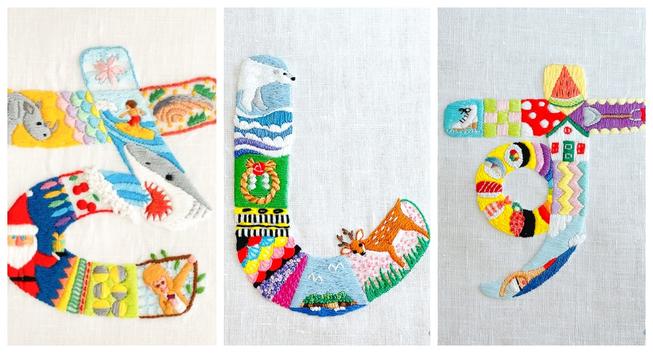Recent searches
Search options
#hiragana
Artist Tomoko Kubo is embroidering all 46 hiragana characters with each piece including images that show foods, animals and activities that begin with the character. Just beautiful!

The #JapaneseLanguage is renowned for its unique linguistic and cultural heritage. Its complex grammar and writing system
My #hiragana reading is pitifully slow. Need to practice more.
OK, I made another batch with slightly more sugar this time around (roughly 55% quince and 45% sugar). Now the previous batch needed a special marker to remind myself that it's just a tad bit more sour ("suppai").
And nope, this wasn't easier to write. Like, at all. 
@jredlund @ashenwave
Hehehe. One of the reasons I'm a writer and not a public speaker is that I can revise. English is harder than many languages as there are too many sounds to depict and nobody wants to read/write a phonetic alphabet. I suspect if some tried, there are too many accents and alternate pronunciations to agree on a standard spelling in it. Yes. Syllabary. I'd always thought it would be cool if people would get together and reprint #Japanese kanji literature in #Hiragana (maybe with kanji as furigana), the language could become so accessible as to rival English. If people didn't need to use #kanji, would they? Yes, I'll admit it does speed up reading. In any case, with the computational tools and cell phones today, it ought be easy to translate things like newspapers and literature to Hiragana on the fly. Not a way to pass the #JPT, but living in the states were immigrants talk fluently in their native language but admit to losing their use of Kanji, it makes more sense than one might first think. To me, anyway.
I'm a heretic.
nuova roba in NiseNoTori (Uccello Impostore), la mia piccola webapp che imparare #Katakana e #hiragana
Ho aggiunto il sillabario con pronuncia e stroke orders.
E finalizzato il gioco Guess con animazioni e cross-kana.
Presto:
- Statistiche
- Custom Charset
- Match the Pair
- Syllable Combo
(codice sorgente: https://github.com/vikkio88/nisenotori)
ho aggiunto due giochi a NiseNoTori, il mio piccolo tool per imparare #hiragana e #katakana
Un gioco è semplicemente un AnkiDeck, l'altro è un duolingo senza limite di errori.
codice qui: https://github.com/vikkio88/nisenotori
i dont like ussr but their anthem was the first #russian thing i could think so have it written with #hiragana and #hangul
そゆず ねるしいみひ れすぷぶりいく すをぼづにひ
すぷりおちりあ なゑき ゑりいかや るし
だ すづらをすつをえつ そずだに をりえゆ なろどを
えぢに、もぐちい そゑつき そゆず
소유쓰 네루치미 렛부쁘릭 숴뽀뜨늫
습료디랴 나웨기 웨리거야 륫
따 쓰뜨라웃두옏 솠딴이 워례이 나로쪼우
예띠니 모꾸찌 소왲기 소윴
ive made some rules to write russian with these systems, but they're not that good as latinics anyway
you can listen it in google translatr if u cnt read
today i tried to make rules for writing russian with hiragana. thats not very practical and is not that good as my latinic version, but is funny how google translator reads it
ぽつらちえのを をれめに じあり
な しと や つらちう すをゆ じいずに
#languages #russian #japanese #hiragana #conlang
ed ecco la terza iterazione e il primo giochino quasi completo di NiseNoTori, uccello finto, un piccolo giochino per memorizzare #hiragana e #katakana mentre imparo il giapponese a caso.
sito: https://nisenotori.surge.sh/
codice: https://github.com/vikkio88/nisenotori
Suggerimenti/Consigli?
Nella roadmap ho:
Guessing Game alla Duolingo.
Aggiungere pronuncia/ strokes orders.
and this is what Nise No Tori (Fake Bird) Kata Training app looks like after 2 hours total of work.
I need to add the ability to select subsets of kata and an end game with possible repetition of wrong ones like Anki.
e come ogni cosa alla quale mi appassiono, finisco per farci un tool.
Come dicevo è da una settimana e mezza che ho cominciato a studiare un po' di giapponese così a caso per tenermi il cervello allenato e siccome #anki mi fa schifo per imparare #hiragana e #katakana sto lavorando al mio tool personalizzato rippando roba da Duolingo, si chiama Nise no tori, uccello impostore.
scritto in #svelte: https://nisenotori.surge.sh/
codice qui: https://github.com/vikkio88/nisenotori
per ora è solo un placeholder.
Is it in any way acceptable to use #Hiragana / #Katakana instead of the usual #Greek #Alphabet for the #Math #Equations in a #Paper? I just found out that I find it a lot easier to create short and easy to read telling names for my variables. For example, "Descriptive Norms" can be abbreviated as "DeNo" which can be written as "での". (And yes, I know that I could just write "DeNo" in the first place but that's not the point here. :D )
Well, I finally went ahead and learned #Katakana. I think it should make learning #Kanji a bit simpler since one of the pronunciations is always written in #Katakana, which I wasn't able to read. And more importantly, I can finally read the lyrics of the songs in my library. I still love how you can just guess the meaning from the pronunciation. Can't do that with #Hiragana words, that's for sure.
My #language history: en > tl > ja > fil > fsl
Currently learning: he and ko
---
en: #English
tl: #Tagalog
ja: #Nihongo (#Japanese)
fil: #Filipino
fsl: #FilipinoSignLanguage
he: #Hebrew
ko: #Hangugeo (#Korean)
---
For the writing systems:
Of course, Latin writing system is the default for English, Tagalog, and Filipino.
However, we do have a pre-Colonial writing system called #Baybayin (an umbrella term), a.k.a. #Surat and #Suyat.
For Nihongo, I studied #Hiragana and #Katakana but not #kanji
Still learning the writing system for:
* Hebrew
* Korean, which is called #Hangul
The real challenge is using these languages and writing systems. For example, I need a serious refresher for Nihongo, Hiragana, and Katakana. I self learned it when I was six (6) years old. Around mid-20s, I started to forget my Japanese. (And I never learned Kanji, LOL.)
Still, my favourite is (Filipino) #SignLanguage. That I need a refresher too. I think I was Grade 9 when I signed-up for sign language classes (outside school), and that was in the mid-90s.
#Languages, it's fun to learn, be it on your own or formal schooling. The way you analyse and think also shifts with the language you use for communication, so it is important to communicate with the proper language.
Example, in Tagalog and Filipino languages, the English "love" can be translated into "mahal" and "iniibig" (there are others).
"Mahal" is, just, "love". But "iniibig" is deeper and romantic. It can't be directly translated into English (but possible in some Asian languages). The closest we can get in English is "deeply love" but a lot is still lost in translation because "iniibig" is also profound, and forever. You can't just say it to another. We can probably say, "iniibig" can only be used for your soulmate.
So, here in the #Philippines you can say "I love you" in English, but there's no meat to it. It's shallow.
But when you say, "Mahal kita", there's seriousness and meat to it.
However, once you say, "Iniibig kita", it's a whole new level, deep level of love (confession). Anyone who hears it will pause and try to process it.
The way we analyse and think is influenced by the language we use to express it.
- https://kuzuri.neocities.org/resources
- https://developer.mozilla.org/en-US/docs/Web/CSS/list-style-type#hiragana

